At MHV we test each and every pump that is shipped out of our facility. Testing validates our workmanship has met the standard of quality and that each system performs within specification. For oil booster pumps we conduct throughput testing and on diffusion pumps we determine the base vacuum. A common vacuum gauge we use for these measurements is the Pirani gauge.
The thermocouple gauge was popular in the past but has two limitations: slow response and limited range. This gauge has a fine wire filament heated by a constant alternating current source. A fine wire thermocouple pair is then welded to the center portion of this wire to measure its temperature.
As the vacuum level is lowered, the wire temperature increases due to lower thermal conductivity of the surrounding gas. The thermocouple output is in millivolts and is read out either on an analog meter or digitally. There is no zero or span adjustment. Pre-evacuated standard gauges can be used to check calibration.
Generally, three separate sensors are needed, 20 to 1 torr (1000 microns), 1000 microns to 1 micron, and 100 microns to 1 micron. Thermocouple gauges from atmosphere to 20 torr area are not available.
The Pirani gauge uses a similar fine wire filament but it is connected as one arm of a Wheatstone bridge. The bridge can be fed with a constant voltage DC source. As the sensor is evacuated the wire temperature increases causing the wire resistance to increase thus unbalancing the bridge. The bridge unbalance signal is conditioned and read out digitally. Additional resistors connected to the bridge circuit allow for ambient temperature compensation.

Another variant uses the same Wheatstone bridge but the bridge supply voltage is varied in order to maintain bridge balance. The variation in bridge supply voltage is compared to a reference voltage and the output conditioned and read out digitally.
Piranis have fast response and a wide range, typically from atmosphere (760 torr) down to ½ micron (5 x 10-4 torr). All of them have zero and span adjustments either on the sensor or on the gauge readout electronics. The Granville Phillips Convectron and Leybold Thermovac are examples of the Pirani gauge.
Another important consideration using the Pirani gauge is the Gas dependent actual pressure. Heat conductivity is quite variable among gases and vapors and Pirani gauge calibration is dependent on the heat conductivity of the surrounding gas. Since gauges are typically calibrated in air, a gas dependent curve chart is generally consulted to determine the change of indicated pressure to actual pressure when the process atmosphere pressure measured is something other than pure air. Additionally, the filament can become contaminated and introduce error due to changes in resistance of the coated filament. Typical oil contamination will cause the gauge to read high. The Pirani gauge has proven reliable and convenient.

